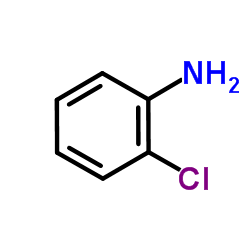Tissue distribution, subcellular localization and covalent binding of 2-chloroaniline and 4-chloroaniline in Fischer 344 rats.
L D Dial, D K Anestis, S R Kennedy, G O Rankin
文献索引:Toxicology 131(2-3) , 109-19, (1998)
全文:HTML全文
摘要
Chloroanilines (CA) are widely used chemical intermediates which induce numerous toxicities including hematotoxicity, splenotoxicity, hepatotoxicity and nephrotoxicity. Although chloroaniline-induced hematotoxicity has been studied in detail, little information is available on the organ-directed toxicity seen following exposure to these agents. The purpose of this study was to examine and compare the excretion and distribution of two nephrotoxicant and hepatotoxicant chloroanilines (2- and 4-chloroaniline) to liver, kidney, spleen, plasma and erythrocytes. Subcellular distribution and covalent binding in kidney and liver were also determined. Male Fischer 344 rats (four per group) were administered [14C]-2-chloroaniline or [14C]-4-chloroaniline (0.5 or 1.0 mmol/kg; approximately 50 microCi/rat) intraperitoneally (i.p.). Urine, feces, blood and tissues were collected at 3 and 24 h. Both 2- and 4-chloroaniline-derived radioactivity were primarily renally excreted with < 1% excretion in the feces by 24 h post-treatment. Both chloroanilines accumulated mainly in liver (percentage of administered dose/total tissue), but kidney generally had similar or higher equivalent concentrations (micromol/g tissue) compared to liver. Subcellular distribution revealed that for both chloroanilines, the cytosolic fraction generally had the highest level of radioactivity independent of time or dose. Covalent binding was detected in both liver and kidney, with the highest concentration (pmol/mg protein) of binding observed in the hepatic microsomal fraction regardless of compound, dose or time studied. In general, 2-chloroaniline derived radioactivity was excreted faster, reached peak tissue concentrations earlier, disappeared from tissues faster and had less covalent binding in target tissue at 24 h than 4-chloroaniline-derived radioactivity. These results suggest that the increased toxic potential of 4-chloroaniline as compared to 2-chloroaniline may be due in part to a more prolonged and persistent accumulation of 4-chloroaniline and/or its metabolites in target tissue.
相关化合物
| 结构式 | 名称/CAS号 | 分子式 | 全部文献 |
|---|---|---|---|
 |
2-氯苯胺
CAS:95-51-2 |
C6H6ClN |
|
Optimizations of packed sorbent and inlet temperature for la...
2014-08-22 [J. Chromatogr. A. 1356 , 221-9, (2014)] |
|
Biodegradation of 2-chloroaniline, 3-chloroaniline, and 4-ch...
2010-07-15 [J. Hazard. Mater. 179(1-3) , 875-82, (2010)] |
|
Biodegradability of chlorinated anilines in waters.
2007-04-01 [Biomed. Environ. Sci. 20(2) , 141-5, (2007)] |
|
Ionic liquid for high temperature headspace liquid-phase mic...
2005-04-22 [J. Chromatogr. A. 1072(1) , 3-6, (2005)] |
|
The utilization of aniline, chlorinated aniline, and aniline...
2001-04-01 [Water Res. 35(5) , 1219-24, (2001)] |